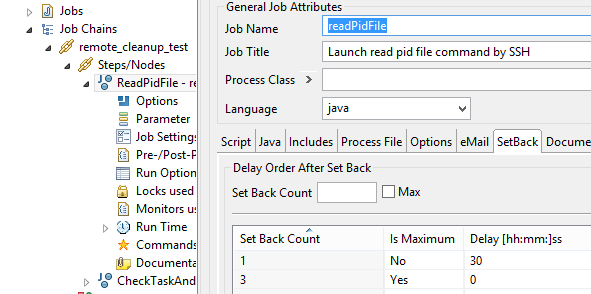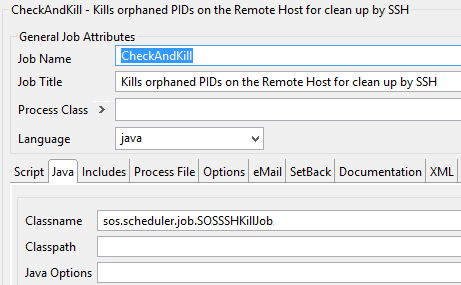| Display feature availability | ||
|---|---|---|
|
Mode Of Operation
To use the SSH Session Management you have to configure your SSH Job and define a second jobchain job chain for the cleanup work.
The feature is available only with the use of the JSch implementation by JCraft. To configure your SSH Job to use the JSch implementation, see How To - Usage of the SOSSSHJob2JSAdapter Job with JCrafts JSch .
The SSH Session Management checks and processes depending on the following conditions:will carry out one of the following actions after checking the remote processes and JobScheduler tasks:
- a remote process is running and the JobScheduler Task is still alive:
- do nothing to do, the cleanup jobchain job chain goes to a setback condition and waits for another start
- a remote process is running but the JobScheduler Task is not no longer available anymore:
- the cleanup job tries to end the process on the remote host
- a remote process is not no longer available anymore but the JobScheduler Task is still running:
- the cleanup job ends the Task immediately
- a remote process and the JobScheduler Task are not available anymore
- do nothing to do, the cleanup job ends
Adjust the SSH Job to be monitored
To be able to monitor the SSH Job you have to add some additional parameters A number of additional parameters have to be added to the job configuration . before the SSH Job can be monitored:
runWithWatchdog
- format:
- boolean
- default value:
false
- description:
- If this parameter is set to true, the job itself is aware that it is monitored and generates an new order for the second jobchain job chain with all parameters of the job and the pid of the connected shell. If the parameter is set to false or is not present the SSH Session Management will not be processed.
...
- format:
- String
- default value:
- empty
- description:
- This parameters defines the path to the configuration files of the jobchain job chain to use for the cleanup work.
...
- format:
<command> \${pid}
- default value:
kill -9 \${pid}
- description:
- The command to kill a process on the remote machine. The command depends on the OS of the remote host. If the command is not set, the cleanup Job job checks whether the remote host if it runs is running on a Linux or on a Windows system and uses the related default relevant appropriate commands.
The placeholder${pid}placeholder will be substituted by the cleanup job and . Note that the leading $ character has to be escaped with "\".
- The command to kill a process on the remote machine. The command depends on the OS of the remote host. If the command is not set, the cleanup Job job checks whether the remote host if it runs is running on a Linux or on a Windows system and uses the related default relevant appropriate commands.
ssh_job_terminate_pid_command
- format:
<command> \${pid}
- default value:
kill -15 \${pid}
- description:
- The command to terminate for terminating a process on the remote machine. The This command depends on the OS of the remote host. If the command is not set, the cleanup Job checks whether the remote host if it runs is running on a Linux or Windows and on a Windows system and uses the related appropriate default commands.
The placeholder${pid}will placeholder will be substituted by the cleanup job and . Note that the leading $ character has to be escaped with "\".
- The command to terminate for terminating a process on the remote machine. The This command depends on the OS of the remote host. If the command is not set, the cleanup Job checks whether the remote host if it runs is running on a Linux or Windows and on a Windows system and uses the related appropriate default commands.
ssh_job_get_pid_command
- format:
<command>
- default value:
echo $$
- description:
- A command or script to write that writes the pid of the connected shell to stdout of the remote host.
...
- format:
<command> \${pid} \${user}
- default value:
/bin/ps -ef | grep \${pid} | grep \${user} | grep -v grep
- description:
- The command or script to check checks if the process on the remote host is still running. The cleanup job expects an exitcode = 0 if the process is still running or other than 0 if the process is not available anymore. The command or script depends on the OS of the remote host. If the command is not set, the cleanup Job checks whether the remote host if it runs is running on a Linux or Windows and on a Windows system and uses the related appropriate default commands.
The placeholders${pid}and${user}placeholders will be substituted by the cleanup job and . Note that the leading $ character has to be escaped with "\". - command exampleExample commands:
/bin/ps -ef- writes all running processes to stdout on the remote host
| grep \${pid}- filters the result to show only results containing the given ${pid}
- filters the result to show only results containing the given ${pid}
| grep \${user}- filters the result to show only results containing the given ${user}
| grep -v grep- filters the grep command itself
- filters the grep command itself
- The command or script to check checks if the process on the remote host is still running. The cleanup job expects an exitcode = 0 if the process is still running or other than 0 if the process is not available anymore. The command or script depends on the OS of the remote host. If the command is not set, the cleanup Job checks whether the remote host if it runs is running on a Linux or Windows and on a Windows system and uses the related appropriate default commands.
...
| Code Block | ||||||
|---|---|---|---|---|---|---|
| ||||||
<job order="yes" stop_on_error="false" title="Launch commands or executable files by SSH">
<description>
<include file="jobs/SOSSSHJob2JSAdapter.xml"/>
</description>
<params>
<param name="host" value="[HOST]"/>
<param name="port" value="[SSHPORT]"/>
<param name="user" value="[USERNAME]"/>
<param name="password" value="[PASSWORD]"/>
<param name="auth_method" value="password"/>
<param name="command_script_file" value="[PATH_TO_SCRIPTFILE]\test_sleep_90s.sh"/>
<param name="runWithWatchdog" value="true"/>
<param name="cleanupJobchain" value="kill_jobs/remote_cleanup_test"/>
<param name="ssh_job_kill_pid_command" value="kill -9 \${pid}"/>
<param name="ssh_job_terminate_pid_command" value="kill -15 \${pid}"/>
<param name="ssh_job_get_pid_command" value="echo $$"/>
<param name="ssh_job_get_active_processes_command" value="/bin/ps -ef | grep \${pid} | grep \${user} | grep -v grep"/>
</params>
<script java_class="sos.scheduler.job.SOSSSHJob2JSAdapter" language="java"/>
<run_time/>
</job> |
Configuration Of The Cleanup
...
Job Chain
A second job chain with two jobs has to be configured to To process the cleanup of the remote processes or the JobScheduler task a second Jobchain with two jobs has to be configured.
The cleanup Jobchain job chain consists of two Jobsjobs, one to read the pid of the connected shell from a temporary file on the remote host and one to check if the process or the JobScheduler Task is still running and to end that . The second job also ends either the remote process or the JobScheduler Task respectivelytask as appropriate.
Job 1: The read-pid-from-temporary-file-Job
The first job reads the pid from a temporary file on the remote host. If your SSH Job is configured as described above, a temporary file is will have been created on the remote host. Was ist der Bedeutung v. d. temp file? Configure the Class of the Job in JOE like this:
...
After choosing the relevant Classname class name from the list you have to , configure a setback for the job. Depending on the checked condition as described above the The setback will be used to restart the job according to the conditions found by the job (described above).
Job 2: The check-and-kill-Job
The second job checks if the pid determined by the first job is still active, if the JobScheduler Task is still active and kills the remote process or the JobScheduler Taskbased on the condition as desribed above. Configure task depending on the conditions found. The actions taken are described in the "Mode of Operation" section above.
Configure the Class of the Job in JOE like thisas follows:
Example of the XML Configuration
...

